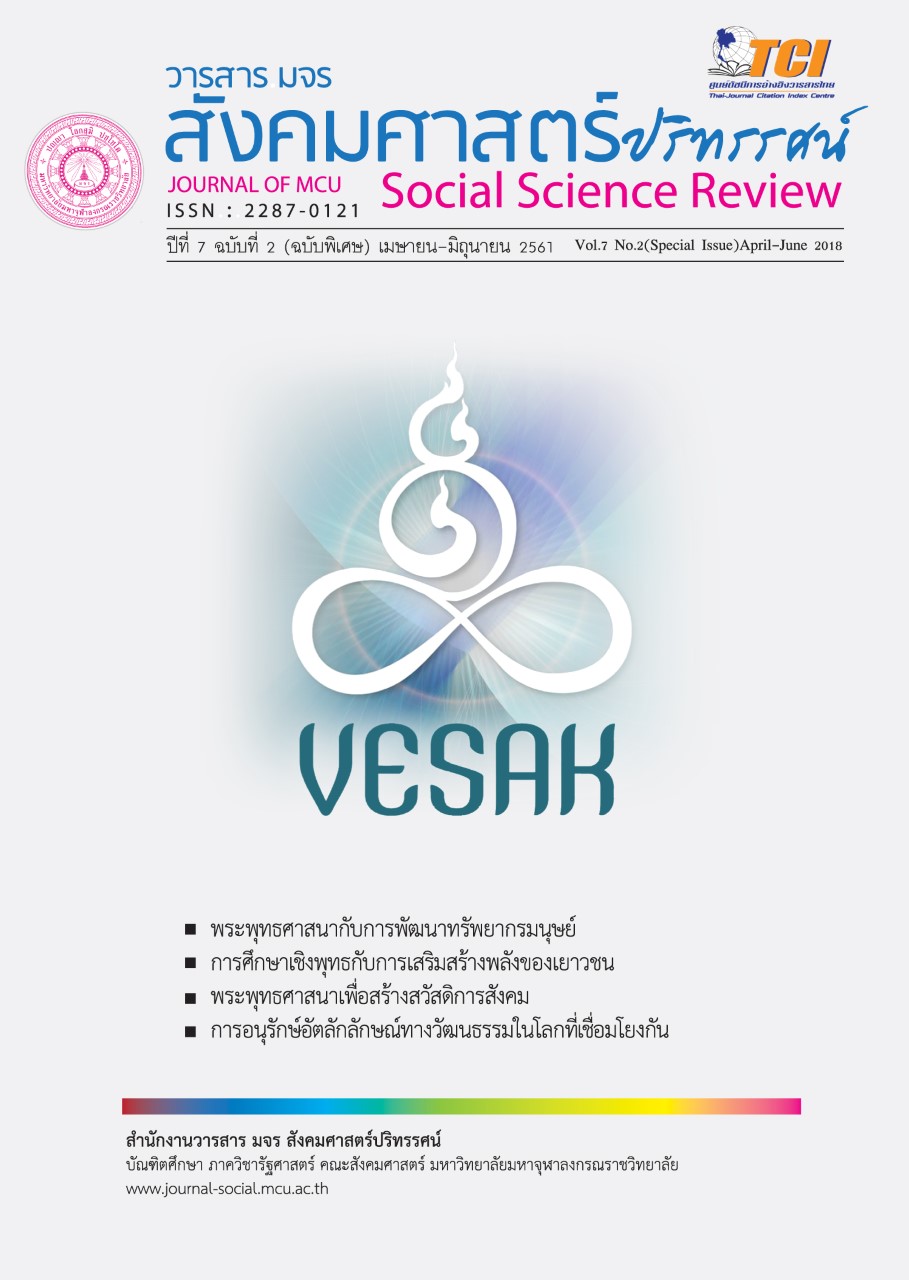การบริหารจัดการด้านศาสนศึกษาแผนกบาลีของพระสังฆาธิการในจังหวัดพิจิตร
คำสำคัญ:
การบริหารการจัดการ, ศาสนศึกษา, พระสังฆาธิการบทคัดย่อ
บทความวิจัยฉบับนี้ มีวัตถุประสงค์1) เพื่อศึกษาการบริหารจัดการด้านศาสนศึกษาแผนกบาลีของพระสังฆาธิการในจังหวัดพิจิตร 2) เพื่อเปรียบเทียบระดับความคิดเห็นของพระสงฆ์ต่อการบริหารจัดการด้านศาสนศึกษาแผนกบาลีของพระสังฆาธิการในจังหวัดพิจิตร โดยจำแนกตามปัจจัยส่วนบุคคล และ 3) เพื่อศึกษาปัญหา อุปสรรค และข้อเสนอแนะเกี่ยวกับการบริหารจัดการด้านศาสนศึกษาแผนกบาลีของพระสังฆาธิการในจังหวัดพิจิตร
ดำเนินการวิจัยแบบผสานวิธี ระหว่างงานวิจัยเชิงปริมาณ ด้วยการสำรวจกลุ่มตัวอย่าง ได้แก่พระสงฆ์ในจังหวัดพิจิตร จำนวน 361 รูป เครื่องมือที่ใช้ในการวิจัยเป็นแบบสอบถาม มีค่าความเชื่อมั่นทั้งฉบับอยู่ที่ 0.974 เป็นทั้งคำถามปลายเปิดและปลายปิด โดยใช้โปรแกรมสำเร็จรูปทางสังคมศาสตร์ในการวิเคราะห์ข้อมูลสถิติที่ใช้ในการวิจัย คือ ค่าความถี่ค่าร้อยละ ค่าเฉลี่ย ส่วนเบี่ยงเบนมาตรฐาน และทดสอบค่า t-test และ F-testและงานวิจัยเชิงคุณภาพ ด้วยการสัมภาษณ์กับผู้ให้ข้อมูลสำคัญจำนวน 10 รูป/คน วิเคราะห์ข้อมูลโดยการวิเคราะห์เนื้อหาเชิงพรรณนา
ผลการวิจัยพบว่า
1)พระสงฆ์มีความคิดเห็นต่อการบริหารจัดการด้านศาสนศึกษาแผนกบาลีของพระสังฆาธิการในจังหวัดพิจิตรในภาพรวมอยู่ในระดับมาก( = 4.07, S.D. = 0.587) และเมื่อพิจารณาเป็นรายด้าน พบว่า อยู่ในระดับมากทุกด้าน คือ ด้านการวัดและการประเมินผล มากที่สุด มีค่าเฉลี่ย ( = 4.12, S.D. = 0.367)รองลงมา ได้แก่ ด้านกิจกรรมการเรียนการสอน มีค่าเฉลี่ย ( = 4.11, S.D. = 0.603)และด้านหลักสูตรมีค่าเฉลี่ย ( = 4.09, S.D. = 0.620) และน้อยที่สุด ด้านการจัดการเรียนการสอน มีค่าเฉลี่ย ( = 3.99, S.D. = 0.654) ตามลำดับ
2) ผลการเปรียบเทียบความคิดเห็นของพระสงฆ์ที่มีต่อการบริหารจัดการด้านศาสนศึกษาแผนกบาลีของพระสังฆาธิการในจังหวัดพิจิตรโดยจำแนกตามปัจจัยส่วนบุคคล คือ อายุ พรรษา
วุฒิการศึกษานักธรรม วุฒิการศึกษาเปรียญธรรม วุฒิการศึกษาสามัญพบว่าพระสงฆ์ที่มี อายุ พรรษา วุฒิการศึกษานักธรรม วุฒิการศึกษาเปรียญธรรม วุฒิการศึกษาสามัญ มีความคิดเห็นต่อการบริหารจัดการด้านศาสนศึกษาแผนกบาลีของพระสังฆาธิการในจังหวัดพิจิตร แตกต่างกันทุกด้านอย่างมีนัยสำคัญที่ระดับ 0.05 จึงยอมรับตามสมมติฐานที่ตั้งไว้
3) ปัญหา อุปสรรค ในการบริหารจัดการด้านศาสนศึกษาแผนกบาลีของพระสังฆาธิการ ในจังหวัดพิจิตร พบว่า 1) เนื้อหาสาระ และภาษาที่ใช้ในหนังสือเป็นภาษาที่เข้าใจยากโดยเฉพาะเนื้อหาสาระในแผนกบาลีเน้นการจำและการแปลมากกว่าความเข้าใจ ขาดการประยุกต์ใช้ ไม่เหมาะสมกับวุฒิภาวะของผู้เรียน 2) การจัดเวลาเรียนยังไม่เป็นระบบ ไม่แน่นอน มีเวลาเรียนน้อยเกินไป จึงไม่สามารถทำความเข้าใจได้อย่างลึกซึ้ง 3) เน้นการท่องจำ และการแปล ไม่ค่อยมีการประยุกต์ใช้และขาดการคิดวิเคราะห์และขาดสื่อที่การเรียนการสอนที่ทันสมัย ข้อเสนอแนะควรนำอิทธิบาท 4คุณเครื่องให้ถึงความสำเร็จ, คุณธรรมที่นำไปสู่ความสำเร็จแห่งผลที่มุ่งหมาย คือ ฉันทะ วิริยะ จิตตะ และวิมังสา 1) ควรให้มีการปรับปรุงหลักสูตร เนื้อหาให้น่าสนใจและง่ายขึ้นเพื่อให้ผู้เรียนมีกำลังใจในการเรียนมากขึ้น และควรเน้นการท่องจำในส่วนที่ต้องใช้เฉพาะหรือที่สำคัญเพื่อนักเรียนเกิดความอยากเรียนมากขึ้นและไม่ท้อต่อการเรียน 2) ควรให้มีการวางแผนในการปรับปรุงหลักสูตรเพื่อให้เหมาะกับยุคสมัย ทั้งในระยะสั้นและระยะยาว และมีแผนปฏิบัติการประจำปี 3) ควรมีการประชุมวางแผนชี้แจงให้ครูผู้สอนเข้าใจในการนำหลักสูตรไปใช้ในการสอนเพื่อให้ผู้เรียนเกิดความเข้าใจมากขึ้นคือง่ายไปหายาก
บทความวิจัยฉบับนี้ มีวัตถุประสงค์1) เพื่อศึกษาการบริหารจัดการด้านศาสนศึกษาแผนกบาลีของพระสังฆาธิการในจังหวัดพิจิตร 2) เพื่อเปรียบเทียบระดับความคิดเห็นของพระสงฆ์ต่อการบริหารจัดการด้านศาสนศึกษาแผนกบาลีของพระสังฆาธิการในจังหวัดพิจิตร โดยจำแนกตามปัจจัยส่วนบุคคล และ 3) เพื่อศึกษาปัญหา อุปสรรค และข้อเสนอแนะเกี่ยวกับการบริหารจัดการด้านศาสนศึกษาแผนกบาลีของพระสังฆาธิการในจังหวัดพิจิตร
ดำเนินการวิจัยแบบผสานวิธี ระหว่างงานวิจัยเชิงปริมาณ ด้วยการสำรวจกลุ่มตัวอย่าง ได้แก่พระสงฆ์ในจังหวัดพิจิตร จำนวน 361 รูป เครื่องมือที่ใช้ในการวิจัยเป็นแบบสอบถาม มีค่าความเชื่อมั่นทั้งฉบับอยู่ที่ 0.974 เป็นทั้งคำถามปลายเปิดและปลายปิด โดยใช้โปรแกรมสำเร็จรูปทางสังคมศาสตร์ในการวิเคราะห์ข้อมูลสถิติที่ใช้ในการวิจัย คือ ค่าความถี่ค่าร้อยละ ค่าเฉลี่ย ส่วนเบี่ยงเบนมาตรฐาน และทดสอบค่า t-test และ F-testและงานวิจัยเชิงคุณภาพ ด้วยการสัมภาษณ์กับผู้ให้ข้อมูลสำคัญจำนวน 10 รูป/คน วิเคราะห์ข้อมูลโดยการวิเคราะห์เนื้อหาเชิงพรรณนา
ผลการวิจัยพบว่า
1)พระสงฆ์มีความคิดเห็นต่อการบริหารจัดการด้านศาสนศึกษาแผนกบาลีของพระสังฆาธิการในจังหวัดพิจิตรในภาพรวมอยู่ในระดับมาก( = 4.07, S.D. = 0.587) และเมื่อพิจารณาเป็นรายด้าน พบว่า อยู่ในระดับมากทุกด้าน คือ ด้านการวัดและการประเมินผล มากที่สุด มีค่าเฉลี่ย ( = 4.12, S.D. = 0.367)รองลงมา ได้แก่ ด้านกิจกรรมการเรียนการสอน มีค่าเฉลี่ย ( = 4.11, S.D. = 0.603)และด้านหลักสูตรมีค่าเฉลี่ย ( = 4.09, S.D. = 0.620) และน้อยที่สุด ด้านการจัดการเรียนการสอน มีค่าเฉลี่ย ( = 3.99, S.D. = 0.654) ตามลำดับ
2) ผลการเปรียบเทียบความคิดเห็นของพระสงฆ์ที่มีต่อการบริหารจัดการด้านศาสนศึกษาแผนกบาลีของพระสังฆาธิการในจังหวัดพิจิตรโดยจำแนกตามปัจจัยส่วนบุคคล คือ อายุ พรรษา
วุฒิการศึกษานักธรรม วุฒิการศึกษาเปรียญธรรม วุฒิการศึกษาสามัญพบว่าพระสงฆ์ที่มี อายุ พรรษา วุฒิการศึกษานักธรรม วุฒิการศึกษาเปรียญธรรม วุฒิการศึกษาสามัญ มีความคิดเห็นต่อการบริหารจัดการด้านศาสนศึกษาแผนกบาลีของพระสังฆาธิการในจังหวัดพิจิตร แตกต่างกันทุกด้านอย่างมีนัยสำคัญที่ระดับ 0.05 จึงยอมรับตามสมมติฐานที่ตั้งไว้
3) ปัญหา อุปสรรค ในการบริหารจัดการด้านศาสนศึกษาแผนกบาลีของพระสังฆาธิการ ในจังหวัดพิจิตร พบว่า 1) เนื้อหาสาระ และภาษาที่ใช้ในหนังสือเป็นภาษาที่เข้าใจยากโดยเฉพาะเนื้อหาสาระในแผนกบาลีเน้นการจำและการแปลมากกว่าความเข้าใจ ขาดการประยุกต์ใช้ ไม่เหมาะสมกับวุฒิภาวะของผู้เรียน 2) การจัดเวลาเรียนยังไม่เป็นระบบ ไม่แน่นอน มีเวลาเรียนน้อยเกินไป จึงไม่สามารถทำความเข้าใจได้อย่างลึกซึ้ง 3) เน้นการท่องจำ และการแปล ไม่ค่อยมีการประยุกต์ใช้และขาดการคิดวิเคราะห์และขาดสื่อที่การเรียนการสอนที่ทันสมัย ข้อเสนอแนะควรนำอิทธิบาท 4คุณเครื่องให้ถึงความสำเร็จ, คุณธรรมที่นำไปสู่ความสำเร็จแห่งผลที่มุ่งหมาย คือ ฉันทะ วิริยะ จิตตะ และวิมังสา 1) ควรให้มีการปรับปรุงหลักสูตร เนื้อหาให้น่าสนใจและง่ายขึ้นเพื่อให้ผู้เรียนมีกำลังใจในการเรียนมากขึ้น และควรเน้นการท่องจำในส่วนที่ต้องใช้เฉพาะหรือที่สำคัญเพื่อนักเรียนเกิดความอยากเรียนมากขึ้นและไม่ท้อต่อการเรียน 2) ควรให้มีการวางแผนในการปรับปรุงหลักสูตรเพื่อให้เหมาะกับยุคสมัย ทั้งในระยะสั้นและระยะยาว และมีแผนปฏิบัติการประจำปี 3) ควรมีการประชุมวางแผนชี้แจงให้ครูผู้สอนเข้าใจในการนำหลักสูตรไปใช้ในการสอนเพื่อให้ผู้เรียนเกิดความเข้าใจมากขึ้นคือง่ายไปหายาก
เอกสารอ้างอิง
Ministry of Education. (1998). The Development of Buddhist Pali Canonical Education. Bangkok: Department of Religious Affairs.
PhraMahaVajnavirudee (2004).Pali Education History of the Thai Buddhist Sangha in Siam.Bangkok: Printing Workshops.
PhraThepPariyatSuthi (VoravitCogakarm) (2002).The monks and the religious. Bangkok: Mahachulalongkornrajavidyalaya University Press.
Prayer for the palliative merit (Mahayana). (2016).The development of the Pali Canon Buddhist Ecclesiastical Management Efficiency in Monastic Discipline Region 14(Doctor of Thesis). Graduate School: Mahachulalongkornrajavidyalaya University
PhraMahaTheeraSukumarro (Panchai). (2014).Pali Canonical Study: Case Study WatPhraMahathat Bangkok YaiBangkok(Master of Thesis).Graduate School: Mahachulalongkornrajavidyalaya University
MahasarapongManun (2008).Factors Affecting Success in Prajadhipok School A case study of the Buddhist Scripture School, Bali Temple, Takiab district, TakProvince, NakhonSawan province (Master of Thesis).Graduate School: Phranakhon Si Ayutthaya Rajabhat University
PhramahaamnatPawatthano. (2014). The development of Buddhist education(Doctor of Thesic).Graduate School: Mahachulalongkornrajavidyalaya University.
ดาวน์โหลด
เผยแพร่แล้ว
รูปแบบการอ้างอิง
ฉบับ
ประเภทบทความ
สัญญาอนุญาต
ลิขสิทธิ์ (c) 2020 วารสาร มจร สังคมศาสตร์ปริทรรศน์

อนุญาตภายใต้เงื่อนไข Creative Commons Attribution-NonCommercial-NoDerivatives 4.0 International License.
เพื่อให้เป็นไปตามกฎหมายลิขสิทธิ์ ผู้นิพนธ์ทุกท่านต้องลงลายมือชื่อในแบบฟอร์มใบมอบลิขสิทธิ์บทความให้แก่วารสารฯ พร้อมกับบทความต้นฉบับที่ได้แก้ไขครั้งสุดท้าย นอกจากนี้ ผู้นิพนธ์ทุกท่านต้องยืนยันว่าบทความต้นฉบับที่ส่งมาตีพิมพ์นั้น ได้ส่งมาตีพิมพ์เฉพาะในวารสาร มจร สังคมศาสตร์ปริทรรศน์ เพียงแห่งเดียวเท่านั้น หากมีการใช้ภาพหรือตารางหรือเนื้อหาอื่นๆ ของผู้นิพนธ์อื่นที่ปรากฏในสิ่งตีพิมพ์อื่นมาแล้ว ผู้นิพนธ์ต้องขออนุญาตเจ้าของลิขสิทธิ์ก่อน พร้อมทั้งแสดงหนังสือที่ได้รับการยินยอมต่อบรรณาธิการ ก่อนที่บทความจะได้รับการตีพิมพ์ หากไม่เป็นไปตามข้อกำหนดเบื้องต้น ทางวารสารจะถอดบทความของท่านออกโดยไม่มีข้อยกเว้นใดๆ ทั้งสิ้น





